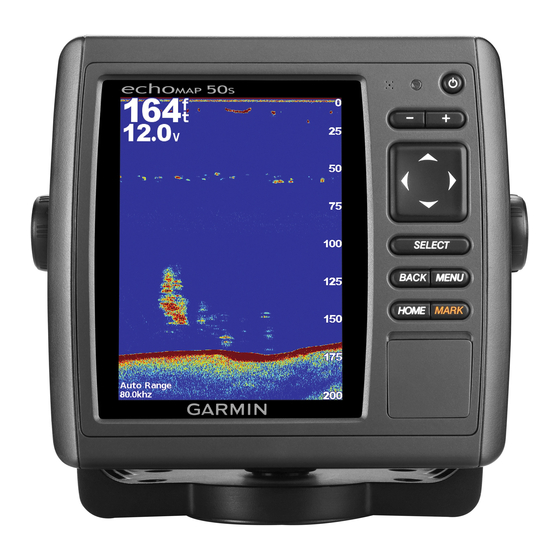• To record the track plot based on a variance from your
course, select Resolution > Change, and enter the
maximum error allowed from the true course before
recording a track point.
Deleting All Saved Waypoints, Routes, and
Tracks
Select Nav Info > Manage Data > Clear User Data > All >
OK.
Combinations
The Combination screen shows a combination of different
screens at the same time. The number of options available on
the Combination screen depends on the optional devices you
have connected to your chartplotter and whether you are using
premium maps.
Selecting a Combination
1
Select Combinations.
2
Select a combination.
Customizing the Combinations Screen
1
Select Combinations.
2
Select a combination.
3
Select Menu.
4
Select an option:
• To change the name, select Name, and enter a new
name.
• To customize the data shown on the screen, select
Overlay Numbers
(page
Gauges and Almanac Information
Gauges provide various information about the trip, engine,
environment, and wind, and are available on all chartplotter
models. Numbers, Compass, and Trip gauges are available on
all chartplotters. Wind and Environment gauges require valid
wind data from the NMEA ® 0183 or NMEA 2000 network.
Engine gauges require a connection to the NMEA 2000
network, so they are not available on all chartplotter models.
The chartplotters also provide almanac information about tides,
currents, and the sun and moon, such as rise and set times.
Viewing the Compass
You can view information about your bearing, heading, and
route using the compass.
Select Gauges > Compass.
Viewing Trip Gauges
Trip gauges show information for odometer, speed, time, and
fuel for your present trip.
Select Gauges > Trip.
Resetting Trip Gauges
1
Select Gauges > Trip > Menu.
2
Select an option:
• To set all the readings for the present trip to zero, select
Reset Trip.
• To set the maximum speed reading to zero, select Reset
Maximum Speed.
• To set the odometer reading to zero, select Reset
Odometer.
• To set all the readings to zero, select Reset All.
Combinations
6).
Viewing Engine and Fuel Gauges
Before you can view engine and fuel gauges, you must be
connected to a NMEA 2000 network capable of sensing engine
and fuel data. See the installation instructions for details.
Select Gauges > Engine.
Customizing Engine Gauge and Fuel Gauge Limits
You can configure the upper and lower limits and the range of
desired standard operation of a gauge. When a value exceeds
the range of standard operation, the gauge becomes red.
NOTE: Not all options are available for all gauges.
1
Select Gauges > Engine > Menu > Gauge Setup > Set
Gauge Limits.
2
Select a gauge.
3
Select Gauge Limits > Custom > Edit Limits.
4
Select an option:
• To set the minimum value of the standard operating
range, select Rated Min..
• To set the maximum value of the standard operating
range, select Rated Max..
• To set the lower limit of the gauge lower than the rated
minimum, select Scale Min..
• To set the upper limit of the gauge higher than the rated
maximum, select Scale Max..
5
Select the limit value.
6
Repeat steps 4 and 5 to set additional gauge limits.
Enabling Status Alarms for Engine Gauges
You can enable the chartplotter to display engine status alarms.
Select Gauges > Engine > Menu > Gauge Setup > Status
Alarms > On.
When an engine alarms occurs, a gauge status alarm message
appears and the gauge may become red depending on the type
of alarm.
Enabling Some Engine Gauge Status Alarms
1
Select Gauges > Engine > Menu > Gauge Setup > Status
Alarms > Custom.
2
Select one or more engine gauge alarms to turn on or off.
Selecting the Number of Engines Shown in Gauges
You can show information for up to four engines.
1
Select Gauges > Engine > Menu > Gauge Setup > Engine
Selection > Number of Engines.
2
Select an option:
• Select the number of engines.
• Select Auto Configure to automatically detect the
number of engines.
Customizing the Engines Shown in Gauges
Before you can customize how the engines are shown in the
gauges, you must manually select the number of engines
(page
11).
1
Select Gauges > Engine > Menu > Gauge Setup > Engine
Selection > Edit Engines.
2
Select First Engine.
3
Select the engine to display in the first gauge.
4
Repeat steps 2 and 3 for the remaining engine bars.
Configuring the Fuel Gauges Display
Before you can configure and display the fuel levels, a
compatible fuel flow sensor or tank level sensors must be
connected to the NMEA 2000 network.
11

